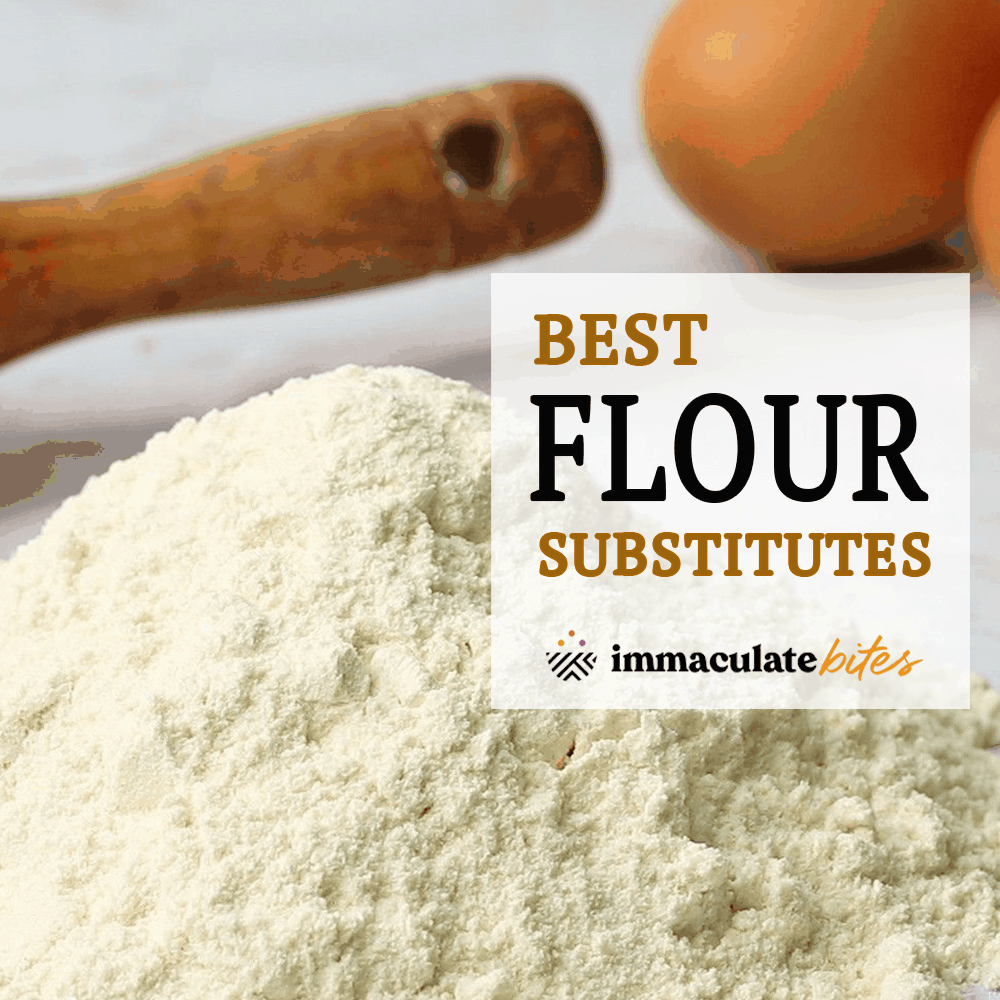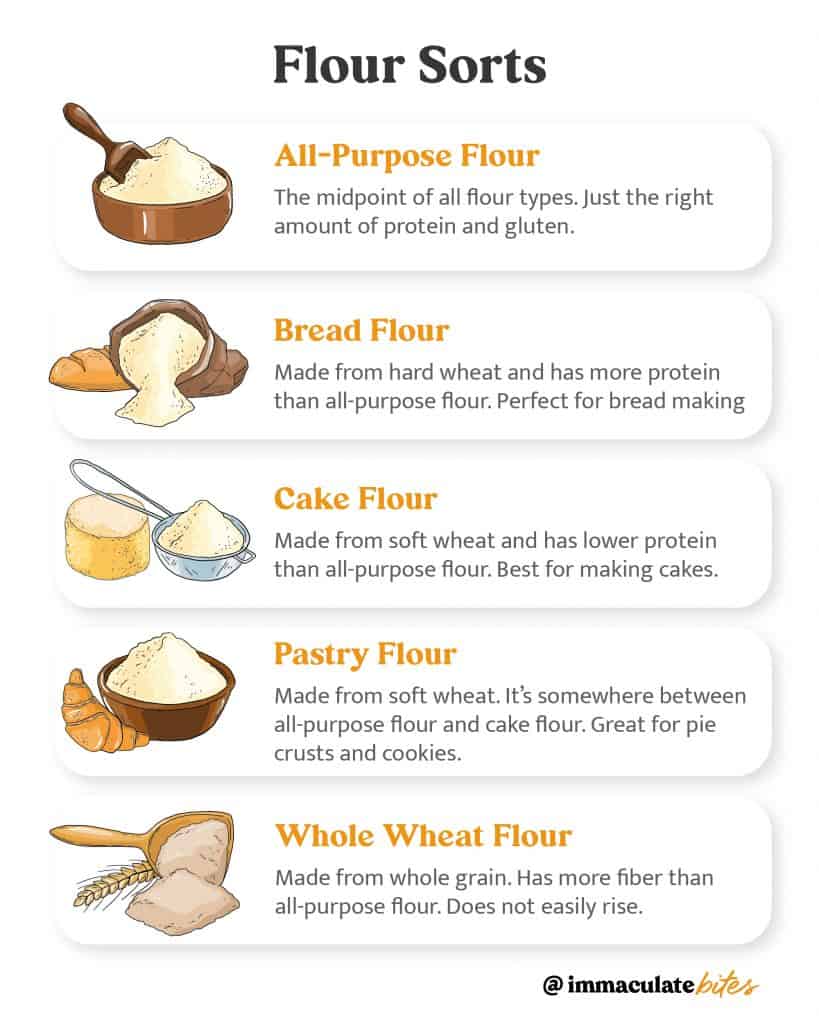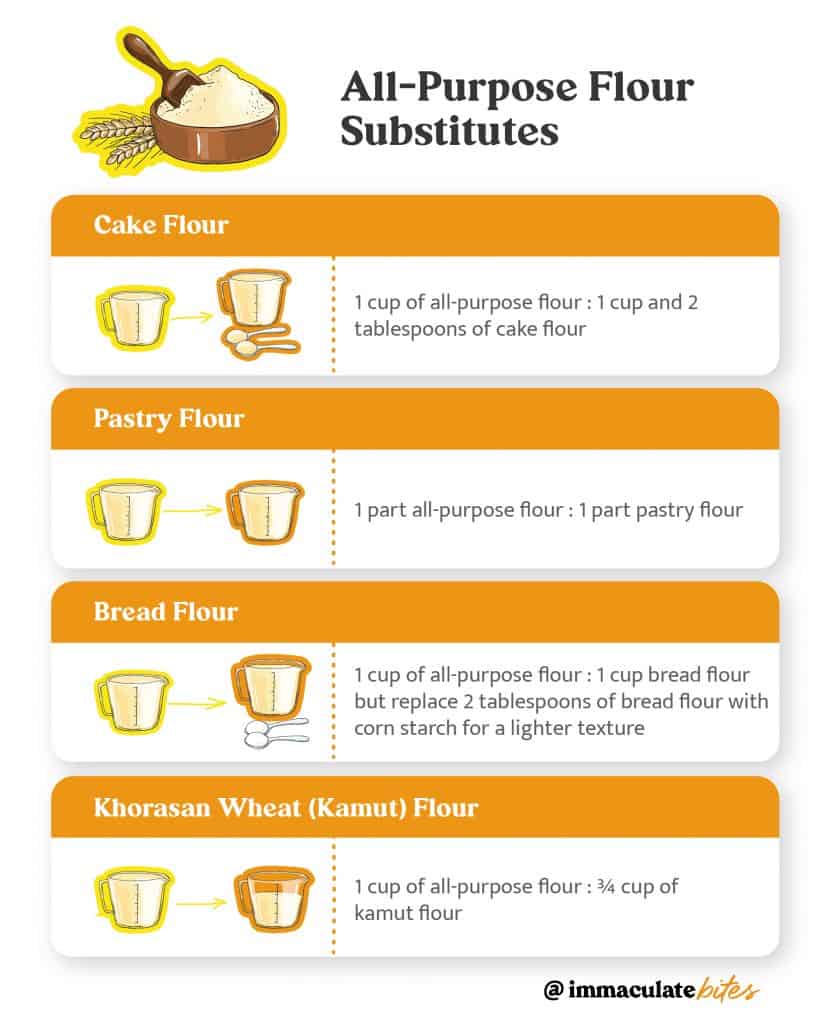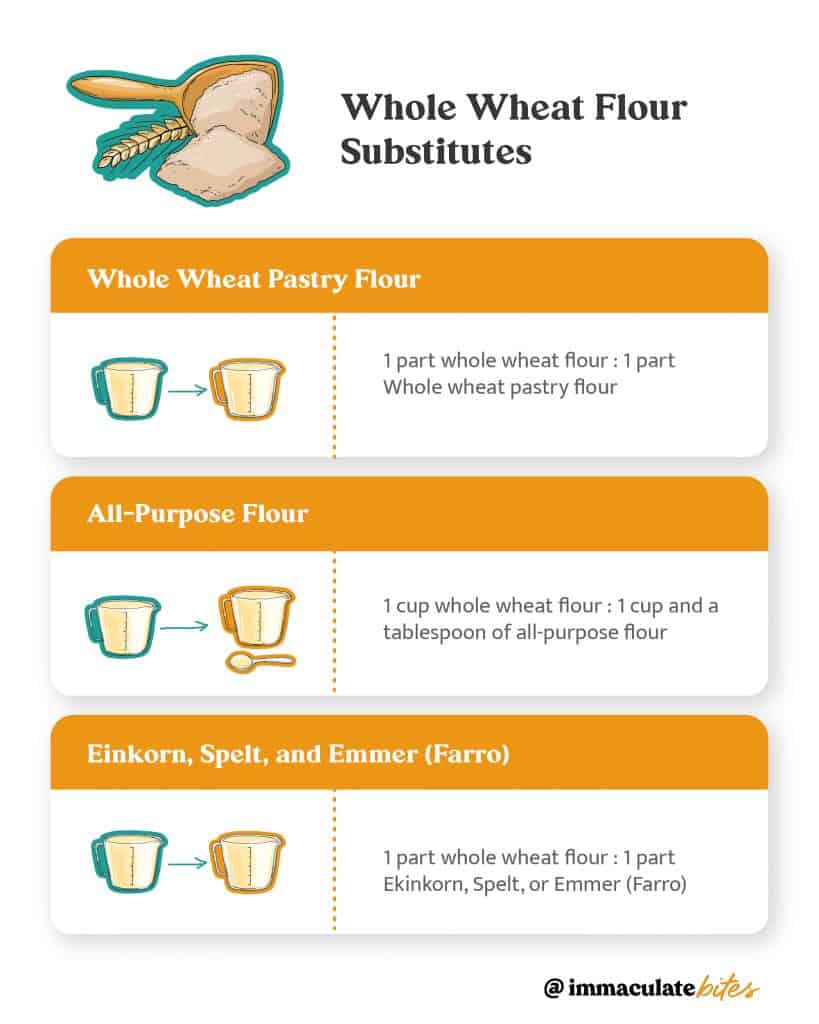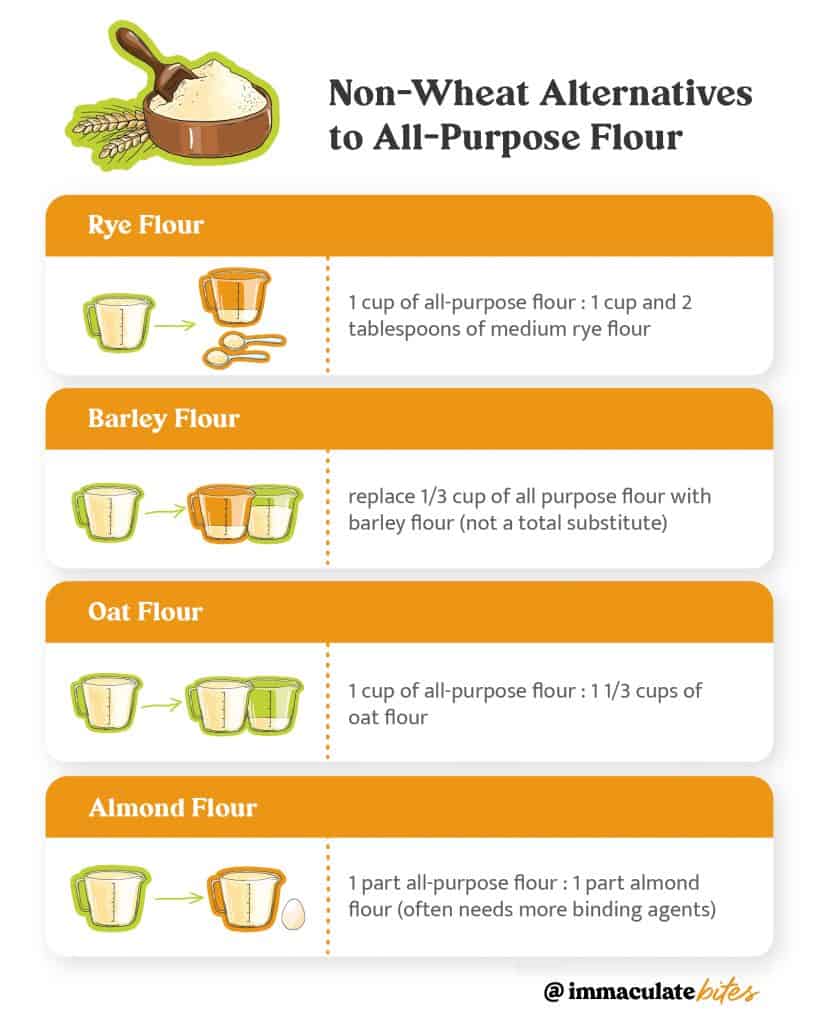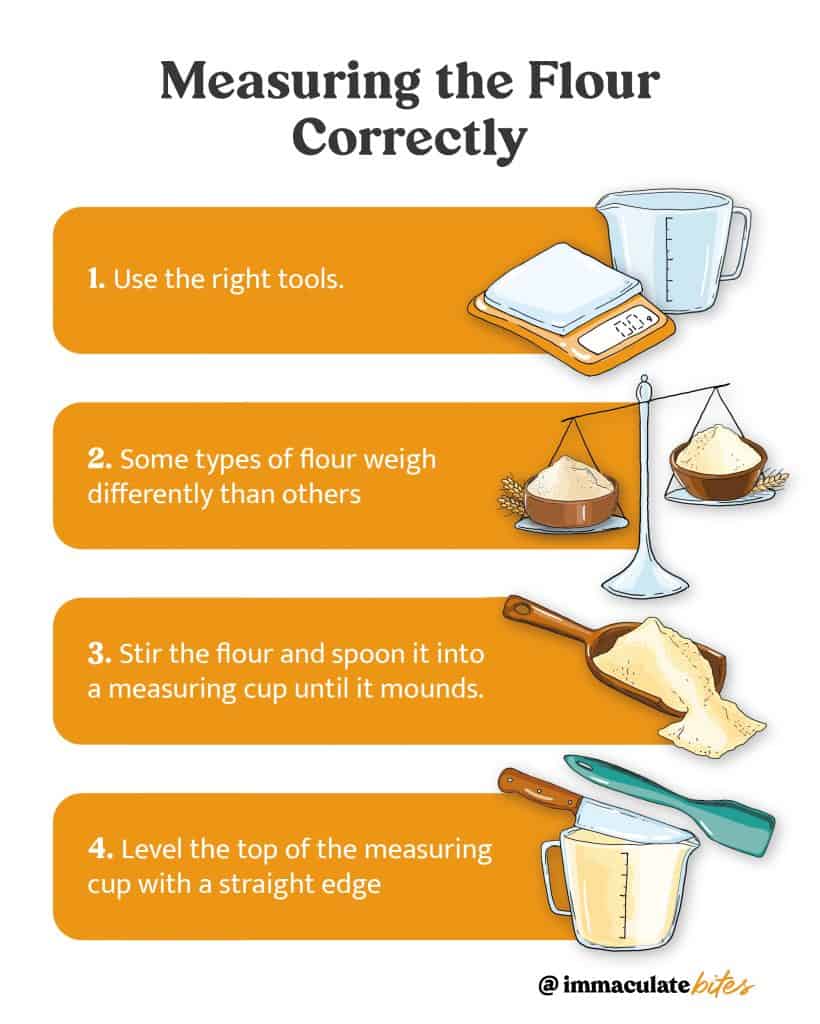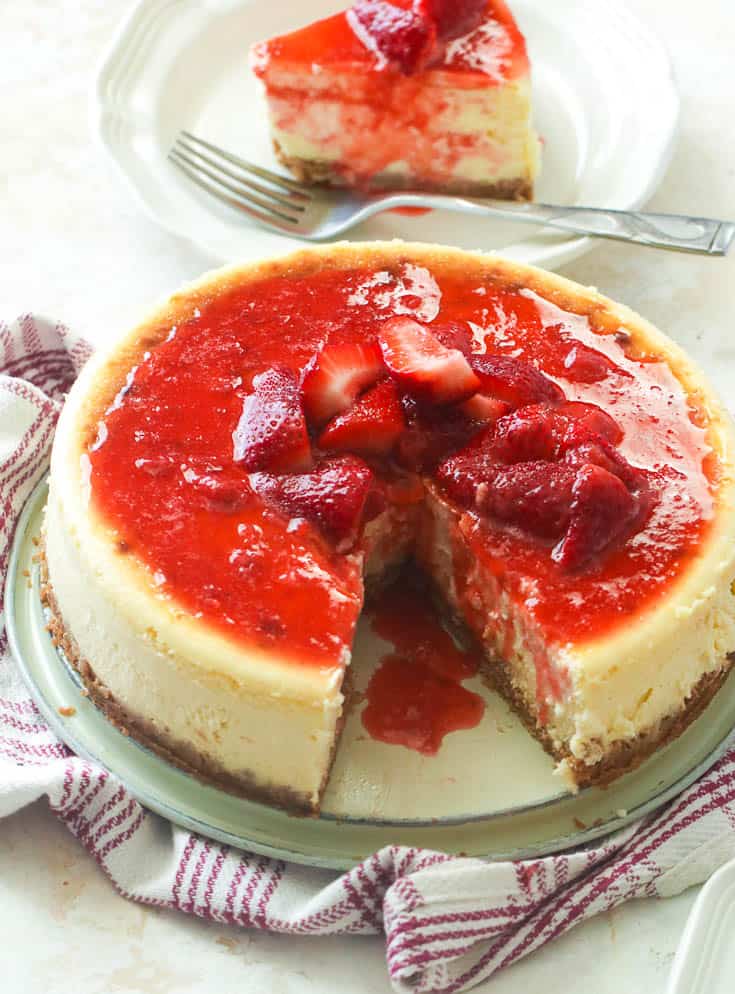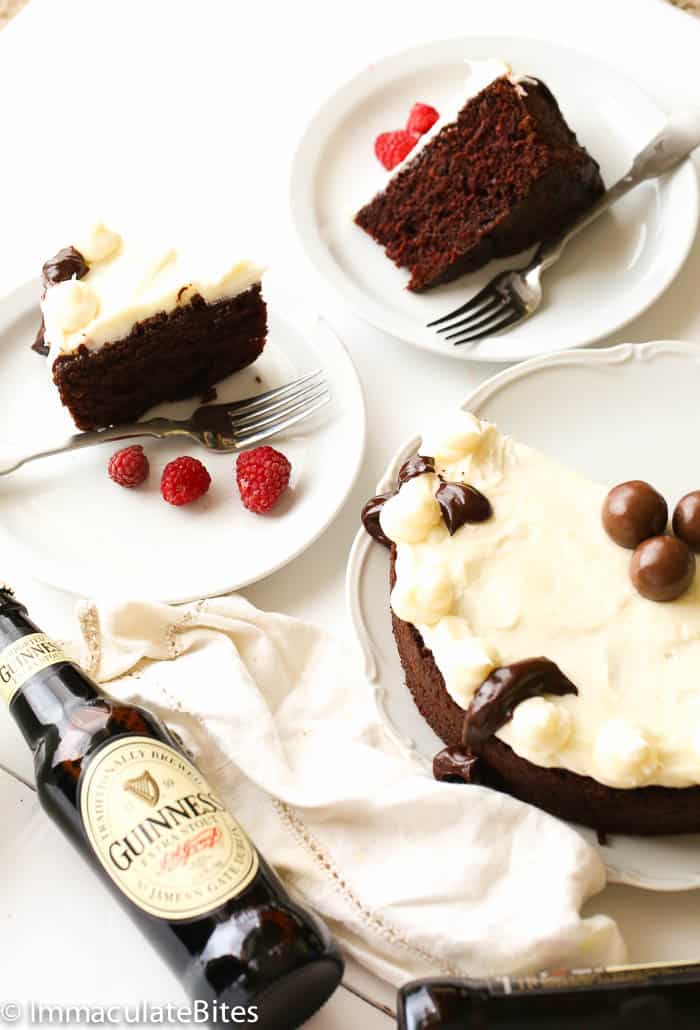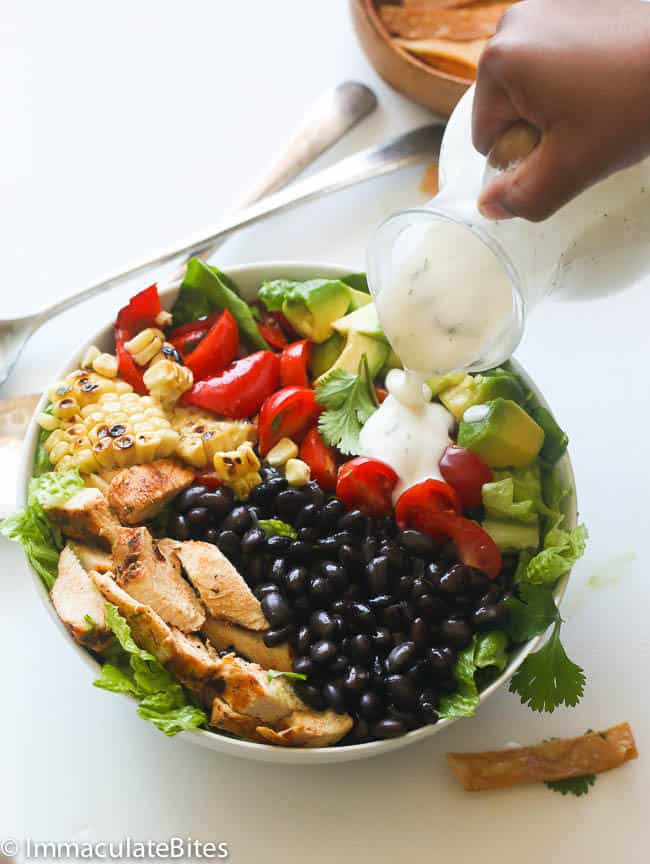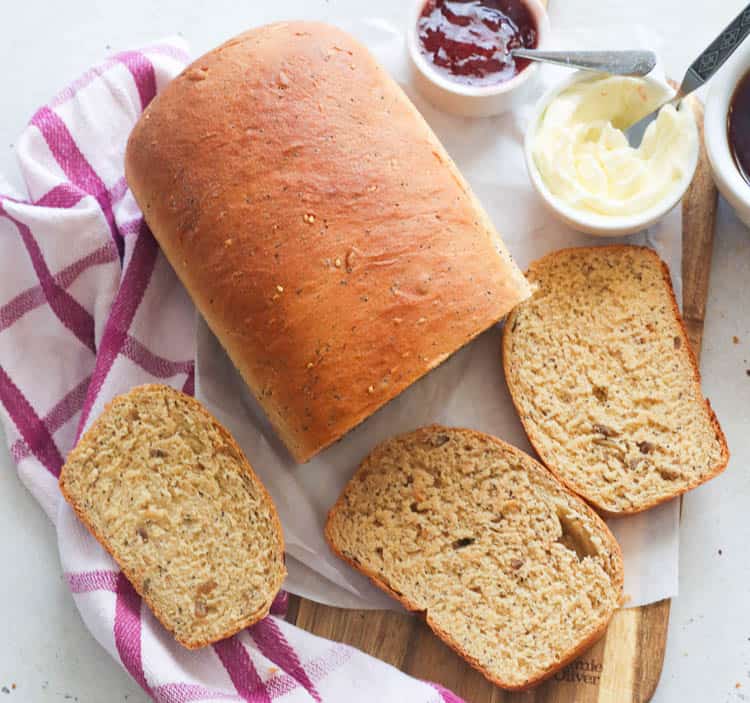Flour Substitutes
Flour substitutes are one of the most frequently asked questions I’m asked. With so many types of flour available now, it’s impossible to have every one of them in your pantry. Unless, of course, you’re a professional pastry chef, and it’s part of your job.
Then there are dietary restrictions and gluten sensitivity. If that is your concern, my heart goes out to you. You can use my list of Gluten-Free Flour Substitutions!
I regularly use several types of flour. Each one has a unique texture and contributes to the dish’s flavor or dessert in its own way.
For example, it may be dough or the thickener in a sauce. It may be rich and creamy, light and fluffy, or flaky and sweet.
The most obvious are cakes, bread, and pastries (sweet and savory). But gravies, sauces, and stews can also have flour in them. So, let’s dive in.
All-Purpose vs. Bread vs. Cake vs. Pastry vs. Whole Wheat
It’s all so confusing! Let’s make it a little easier to understand what all the flour is about. 😍 All-purpose flour and bread flour are the easiest to find. Cake flour and pastry flour are available in most larger grocery stores but may be harder to find in smaller stores.
All-purpose flour is just that. If the recipe just says flour or you can’t figure out what flour is best, use all-purpose.
It is in the middle of the road when it comes to protein content, gluten, and texture.
The endosperm (a fancy word that means the delicious, soft part of the wheat without the bran and germ) from a mix of hard and soft wheat is ground for an all-around useful flour.
If you only have room in your life for one type of flour, make it all-purpose.
Bread flour, made from hard wheat, has more gluten and protein.
It’s the strongest of the flours and can take being kneaded, fermented, left alone, and pounded on without a whimper.
It’s chewy, substantial, flavorful, and (of course) makes excellent bread.
Use it to make this wonderful Basic Homemade White Bread and fill your kitchen with the irresistible aroma of freshly baked bread.
Cake flour, unlike all-purpose flour, is made from only soft wheat.
This flour has a lower protein content (7-9%) than all-purpose flour (10-12%), contributing to the silky texture and making it perfect for tender cakes and flaky, melt-in-your-mouth pastries.
Pastry flour This flour has a lower protein and gluten content somewhere between all-purpose and cake flour.
Also made exclusively from soft wheat, it makes the Best Pie Crust and cookies.
If you prefer whole-grain pastries, you can get whole wheat pastry flour that gives you a softer, lighter texture than regular whole wheat.
Whole wheat flour is from the whole grain, with nothing removed.
It offers better nutrition and fiber. However, it takes more moisture than all-purpose flour, is denser, and doesn’t rise as easily as all-purpose flour. Try it in my delicious Whole Wheat Bread.
Then there is whole wheat pastry flour that gives you the best of both worlds, a soft, comforting texture in a nutritious whole grain.
The Best Flour Alternatives
All-Purpose Flour Substitutes
This flour is the most common and useful staple to have in your pantry. It can replace bread, cake, and pastry flour. We’ll get to that further down. At the moment, what if you don’t have all-purpose flour in the pantry?
- Cake Flour – Substitute 1 cup and 2 tablespoons of cake flour for each cup of all-purpose flour.
- Pastry Flour – If you just realized that you don’t have all-purpose flour, but you do happen to have pastry flour, that would work instead. You can substitute it with the same amount the recipe calls for.
- Bread flour – If you have bread flour, take out 2 tablespoons of flour from each cup and add back 2 tablespoons of cornstarch to lighten the texture and reduce the protein and gluten. One more thing, be careful not to over mix as the protein and gluten will develop and result in a dryer, tougher texture than you would like.
- Khorasan wheat (Kamut) flour – ¾ cup Kamut flour replaces 1 cup all-purpose. This ancient non-hybrid wheat is much more nutritious than modern wheat. It enjoys a firm texture and pleasantly nutty flavor. It’s higher in protein (30% more than whole wheat) and nutrition, as well.
Whole Wheat Flour Substitute
- Whole wheat pastry flour – If you want the nutrition and fiber of whole wheat but the lighter textures of all-purpose flour, you can replace it with the same amount of whole wheat pastry flour.
- All-purpose flour can be an alternative, but the texture won’t be as dense and firm, nor will it be as nutritious. Replacing just half of the whole wheat flour with all-purpose flour will render a softer and lighter texture. Whole wheat is denser and more absorbent. So, if you only have all-purpose flour, add 1 tablespoon flour per cup of flour that the recipe calls for.
- Einkorn, spelt, and emmer (farro) are ancient types of wheat that are easier to digest. Many who have a sensitivity to the commercial strains of wheat can use these flours just fine. With a pleasantly nutty flavor, it’s also more substantial than all-purpose flour. However, the gluten is not as strong, and it a denser texture keeping it rising as easily as regular flour. It is absolutely delicious in cookies, brownies, and quick bread.
NOTE: You can replace flour cup for cup, but reduce the liquid by about a third, and DO NOT OVERMIX.
The texture while mixing may appear to be too moist or sticky. Don’t worry, it’s normal. The ancient form of gluten doesn’t develop like modern gluten, so this flour is excellent for No-Knead Bread.
- Spelt is the closest to all-purpose and bread flour in texture and protein content. Einkorn is very expensive, while spelt and emmer not so much.
Bread, Cake, Pastry, and Self-Rising Flour Substitutes
Bread Flour
It is similar to all-purpose with more gluten and protein, perfect for homemade bread. It has a chewy texture that holds up well with yeast and makes bread such a delight.
All-purpose flour is a good alternative. It won’t have the distinctive chewy texture that pizza crust and bread have, but it will still be delicious.
I just knead it a little longer to get a good texture. Kneading bread is so relaxing.😉
Cake Flour Substitute
All-purpose flour and Cornstarch– Replace cake flour with all-purpose flour, and put 2 tablespoons of cornstarch in a 1-cup dry-ingredient measuring cup. Finish filling the cup with all-purpose flour, then sift the mix twice.
The cornstarch reduces gluten and protein and contributes to a tender and light cake texture. Sifting incorporates air and makes it lighter.
Pastry Flour Substitute
You can replace each cup of pastry flour with 2 tablespoons of cornstarch and ⅞ cup of all-purpose flour.
Sifting lightens the flour, so you don’t accidentally put too much and end up with dry pastry.
Self-rising Flour Substitute
To each cup of all-purpose flour that the recipe asks for, add 1½ teaspoons baking powder and ½ teaspoon salt.
I hardly ever buy self-rising flour since it’s so easy to add the leavening agent and salt to the recipe as I add the flour.
Non-Wheat Alternatives to All-Purpose Flour
Oh, the endless options of flour! And every one of them with its own distinct flavor and texture.
You can replace 20-25% of the all-purpose flour with the flour of your choice if you want to change things up without having to worry about changing other ingredients.
This also works for whole wheat and whole wheat pastry flour.
- Rye flour has gluten but not enough to act as a binder or make it worth your time to knead it. It has a unique, nutty flavor that is popular in Jewish and German bread. If you don’t have rye flour, you can replace it with barley, oat, or millet flour. It won’t have quite the same flavor, but you may not notice if the recipe includes caraway seeds.
- Barley and oat flour can be used interchangeably. Recipes that use these flours usually mix them with all-purpose flour. It just depends on what you already have in the pantry and the flavor you prefer. (Oats may or may not be gluten-free.) You can replace 20-25% of whole wheat or all-purpose flour without worrying about making other changes to the recipe.
- Almond flour is not only a high-protein flour; it is high in vitamins and minerals. It adds a richness to cake and bread that is soooo delicious. You can replace 20% of the all-purpose flour with almond flour in cake and bread without worrying about changing other ingredients. If you want to replace all of the flour with almond flour, add one egg per cup.
Flour for Pasta and Noodles
Semolina and durum flour are made from durum wheat that is the hardest wheat and high in protein and gluten, making it perfect for making pasta and noodles.
The wheat’s endosperm is what goes into semolina, and durum flour is made from what’s left. The following are some excellent substitutes.
- Khorasan wheat (Kamut) flour is the great-great-grandpa of semolina, making it the perfect substitute. It is ancient Egyptian wheat that is easier on the digestion system. Many who have problems with regular wheat can handle this just fine. Not only that, it’s more nutritious. Replace the semolina with an equal amount of Kamut flour.
- Whole wheat and bread flour take runner-ups because they are hard and higher in protein and gluten.
- All-purpose flour can be used if there’s nothing else, but it won’t be as sturdy, and the pasta will need to be cooked immediately after making the dough so it doesn’t dry out and fall apart.
- Corn semolina is a gluten-free option, although your pasta will end up tasting more like corn. That’s not a bad thing. Quinoa and amaranth flour are also common substitutes for pasta.
Different Styles of Ground Corn
I have to admit. I love corn, and it’s nutritious and filling. While popcorn isn’t flour, I could make a meal just with a just big bowl of it.
Getting back on the subject, did you know you can grind popcorn to make cornmeal? The following list describes how you can use what you have.
- Cornmeal is the most popular baking product made with corn. Coarsely ground whole corn is commonly used in cornbread. It is delicious, nutritious, and filling and is the star of this awesome Spoon Bread.
- Corn flour is the whole grain ground very finely. Not to be confused with cornflour (UK) or cornstarch, which is just the grain’s starch. It is gluten-free, so it doesn’t have the binding ability that wheat flour has. An egg or two can take care of that. It makes an excellent substitute for the flour in breading mixes.
- Polenta is another word for cornmeal and has the same versatility. It comes in medium and coarse and can be replaced just fine with cornmeal.
- Grits are a famous southern dish that is typically served with butter and honey. It also goes well with sausage and gravy. The corn in grits is probably the coarsest grind you’ll find.
NOTE: You can substitute the above-listed corn flours for each other.
All are all made from whole corn and can be used interchangeably with a slight difference in texture. Cornstarch or cornflour is only part of the grain and will NOT make a good substitute.
Masa Harina & Cornstarch
Masa harina is a very popular corn flour in Mexican and Central American cuisine. It is made by cooking flint or field corn in slaked lime (calcium hydroxide), then ground and dried.
Who doesn’t like a nice, hot corn tortilla?
It has always been a mystery how the process changes the texture and makes it sticky, giving it the binding power that gluten would typically provide.
The process also makes the nutrients easier to absorb, making what you make with it more nutritious.
If you can’t find it where you are, you can replace a cup of masa harina with a 1/3 cup cornmeal and 2/3 cup all-purpose flour. You could also grind up some dried corn tortillas until you have enough.
Cornstarch is not the whole grain, just the starch.
It’s the softest and most neutral substitute. It is the perfect thickener sauces and gravies.
You can replace it with either tapioca starch or arrowroot powder, though the texture of those two is a little gummy.
More Delicious and Easy Breads and Pastries
How to Measure the Flour Correctly
- To be able to substitute flour, you first need to measure it well. If you have a kitchen scale, that is the best way to measure flour. One cup of all-purpose flour should weigh 125 grams.
- Whole wheat weighs more, and cake and pastry flour weighs less. However, not everyone has a kitchen scale.
- Scooping the flour out of the bag directly into the measuring cup can result in way too much flour, which results in dry, crumbly dough and pudding-like sauces, not good. Instead, lightly stir the flour to loosen it up, then spoon the flour into the dry-ingredient measuring cup.
- Please don’t shake it down or pack it in! Spoon enough flour in so that it mounds, and you can take a straight edge (spatula or the back of a knife) and level it with the top of the measuring cup.
Baking Bread
Baking bread with alternative flour can be a little tricky.
NOTE: Grains have different absorption rates, and you don’t want too dry or too moist results.
The benefits of using various flours are the enjoyment of each grain’s unique flavor and the extra nutrition that usually comes with whole grains, such as oat, barley, and rye.
The gluten may not be as strong in other grains, but using healthy flour makes it worth the challenge.
So how you should do it…
- Begin with replacing 20-25% of the bread or all-purpose flour with your favorite alternative flour.
- As you knead, if you feel it’s too moist, add more flour.
- On the other hand, if it’s too dry, add a little oil or liquid until you get the desired texture.
- I suggest allowing the dough to rest for 10-30 minutes and rechecking the texture. That way, you can feel if it has too little or too much moisture.
Making Batter
Cookies come in different textures that can be rolled out and cut with a cookie cutter or spooned onto the baking sheet.
Cakes, pancakes, and other desserts with a loose batter can be poured into a mold then baked, creating a light, fluffy or dense, rich texture.
These batters are usually a little more forgiving with substitutes.
The flours that absorb more liquid while baking will need to be a little runnier than those with flour that absorbs little moisture.
For example, millet and coconut flour are very absorbent and will need to be pourable.
Almond flour, or almost any nut flour for that matter, is not very absorbent.
Batter made with nuts will need to be thicker, allowing it to be spooned into the mold or cake pan.
Conclusion
It may take some time to play around with ingredients to find out what you personally like.
Some flour alternatives absorb a lot of liquid, some absorb less, and some flours tend to be crumbly, though adding a couple of extra eggs should take care of that.
Finding what works for you is a delicious journey. Enjoy!

